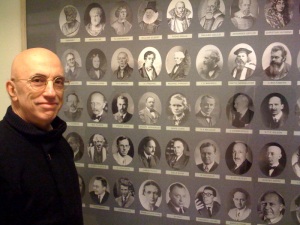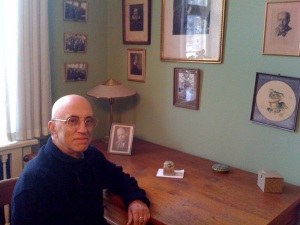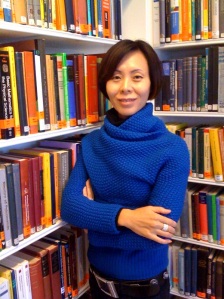Posted by Menas Kafatos
It was a real treat to visit the Niels Bohr Institut in Copenhagen. Located at Blegdamsvej Street, it is an active research institute with a strong history.
Susan arranged with our host John Hertz to visit the Institut and spend some time discussing some of the science as well as visiting Bohr’s office, the Library, etc. John is presently doing computational biology and they have interdisciplinary teams of physicists, biologists and computer specialists working together.
It was great to visit the place where Bohr worked, and so much of the way modern physics works in institutions throughout the world was founded there. Bohr’s more relaxed style for discussions and interactions among scientists may be taken for granted today but that was not always the case in the old European model.
We visited his office and I had the honor to seat at his desk. Pictures of Bohr, including annual pictures of Bohr and entire staff of the Institut hanging from the walls, gifts from other physicists (e.g. Yukawa), the famous yin-yang symbol, which Bohr adopted and is the expression of his complementarity picture, a real treasure, were all there.
Of particular importance were a bust of Einstein and a wall stone image of Rutherford. They showed the importance that Bohr felt for other great physicists. In particular, the bust of Einstein concretely demonstrates the friendship and respect that Bohr had for Einstein. Their friendship has been well documented, but seeing a tangible object from the collection of Bohr, was a true inspiration on the greatness of these famous scientists. So much different than the often back-stabbing attitude of many scientists today, which I suppose can be justified that we live in a very competitive world. However, even though Bohr and Einstein disagreed so fundamentally on the interpretation and consequences of quantum theory, they never stopped being close friends and colleagues. A good lesson to keep in mind, science should rise above the attitudes or ways of individuals. This is unfortunately often set aside by some involved in, e.g., climate research today.
Bohr’s complementarity forms a cornerstone of the “Copenhagen Interpretation” of quantum theory. I have written extensively on this principle and its generalization beyond quantum theory in various articles (see also the book with R. Nadeau, The Conscious Universe, Springer 2000). Being in Bohr’s Institut and seeing his private collection as well as his workplace, was a treat and a break from the events surrounding the “Copenhagen Accord”. I suspect the Copenhagen Interpretation will be more remembered, at least in its advancement of science and broader impacts, than the Copenhagen Accord of December 2009.
We visited the library, with plenty of classical physics monographs, particularly on quantum theory, field theories, etc. In visiting the halls, we came across a picture of many great scientists from antiquity to modern physics. It was a reminder of where we were and the tradition of science. Great science is not done by just individuals, it is often a collective effort. The pictures of the great scientists and thinkers illustrate the continuity of science and knowledge in societies.




